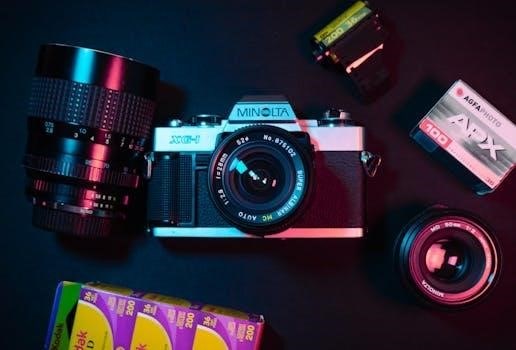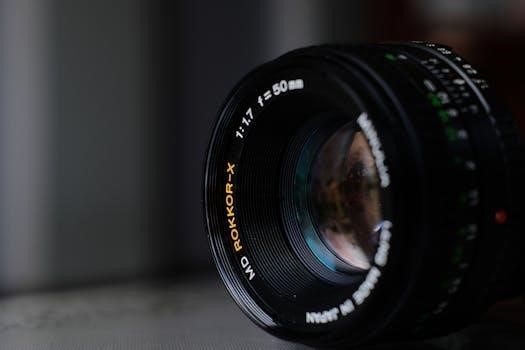The Minolta XG-1, a 35mm SLR from the Minolta SR system, emerged as a user-friendly, budget-conscious alternative in 1977․ This lightweight camera offered an automatic exposure mode and was part of the XG series designed for simplicity and ease of use․ The XG-1 was intended for those who wanted an easy entry point into the world of SLR photography․
Minolta XG Series Overview
The Minolta XG series, introduced in 1977 alongside the more advanced XD series, was Minolta’s answer to the demand for affordable and accessible 35mm SLR cameras․ This series focused on lightweight designs and simplified operation, making them an attractive option for amateur photographers․ The XG lineup, which included models like the XG-1, aimed to provide the core functionality of an SLR without the complexity of professional models․ These cameras featured electronic shutters, automatic exposure modes, and compatibility with the Minolta SR lens mount system․ The series was designed to be easy to use, with a strong emphasis on automatic features to aid those new to SLR photography․ The XG series was a popular choice for its combination of simplicity, compact design, and good image quality for a budget-friendly price point․ The goal was to make SLR photography more accessible to a wider audience, without sacrificing the benefits of interchangeable lenses․ The cameras were intended to be a stepping stone for those looking to learn the art of photography․ The XG series succeeded in making it easier to take high quality photographs․
Target Audience and Purpose
The Minolta XG-1 was specifically targeted towards amateur photographers and those new to the world of 35mm SLR cameras․ Its primary purpose was to offer a user-friendly and affordable entry point into the Minolta SR system․ The camera aimed to simplify the photographic process, allowing beginners to achieve good results with minimal learning curve․ With its automatic exposure mode, it enabled users to concentrate on composition rather than being bogged down with complex manual settings․ The XG-1 was also intended for casual users who wanted a lightweight and convenient camera for everyday photography․ The design focused on ease of use, making it a suitable option for those who preferred point-and-shoot simplicity but also wanted the benefits of interchangeable lenses․ Minolta aimed to capture a broader market segment by offering a camera that was both accessible and capable․ The camera was also intended to be a gateway to more advanced photography techniques, allowing users to gradually explore manual modes when they were ready․ This made the XG-1 a practical choice for people of various levels of interest and skill․
Key Features of the Minolta XG-1
The Minolta XG-1 boasts several key features including automatic exposure, a touch switch metering system, compatibility with Minolta SR lenses, an electromagnetic shutter release, and it is also compatible with Auto Winder G and Auto Electroflash․
Automatic Exposure Mode
The Minolta XG-1’s automatic exposure mode is a cornerstone of its user-friendly design, allowing photographers to capture well-exposed images with minimal effort․ This mode simplifies the shooting process by automatically selecting the appropriate shutter speed based on the light conditions measured by the camera’s built-in light meter․ The photographer only needs to set the aperture․ This feature is especially useful for beginners or for capturing spontaneous moments where manual adjustments might be too time-consuming․ The camera’s metering system assesses the scene’s brightness and adjusts the shutter speed to ensure a proper exposure․ The automatic mode frees the user from the complexities of manual exposure settings․ It is a very convenient feature that is the main reason for the popularity of this model․ The user can choose to override the automatic mode for full manual operation if desired․ The automatic exposure provides a fast and simple way to capture photos with confidence․ This mode allows for easy adaptation to different lighting conditions, making it a versatile option for various shooting situations․
Touch Switch Metering
The Minolta XG-1 incorporates a unique touch-switch metering system, a feature designed for convenient and efficient operation․ Unlike traditional metering systems that require a separate button press, the XG-1 activates its light meter by simply touching a designated area on the camera body․ This touch-sensitive switch allows the photographer to quickly and easily assess the light conditions before taking a picture, without the need for a deliberate and separate action․ This design choice enhances the user experience by reducing the number of steps required to achieve accurate exposures․ The touch-switch mechanism is very responsive and intuitive, making the camera feel more integrated with the user’s actions․ This system makes metering more fluid and allows for faster operation․ The touch switch metering is very helpful in spontaneous situations․ It also provides an ease of use that is very helpful for beginners․ The design is one of the main reasons why the camera is very popular․ The metering system is very accurate and allows users to take great photos․
Compatibility with Minolta SR System Lenses
The Minolta XG-1 is designed to be fully compatible with the extensive range of Minolta SR system lenses, offering users a wide array of options for various photographic needs․ This compatibility includes Auto Rokkor lenses, which provide automatic diaphragm control, as well as RF (mirror-type) lenses and Manual-Preset lenses, which require manual aperture setting․ This broad compatibility is a very useful feature because it allows photographers to use a wide selection of optics․ The ability to interchange lenses greatly expands the camera’s versatility, enabling different focal lengths and perspectives․ Users can therefore choose the perfect lens for landscape, portrait, or macro photography․ This feature makes the XG-1 a great option for both beginners and experienced photographers who want a system that can grow with their needs․ The robust SR mount ensures secure and reliable attachment of lenses․ The user has many options for photography․
Electromagnetic Shutter Release
The Minolta XG-1 features an electromagnetic shutter release, which is a key element in its electronic design․ This type of release offers a smooth and responsive feel when taking a picture, enhancing the overall shooting experience․ Unlike mechanical releases, the electromagnetic system allows for more precise timing and consistent performance; This feature also contributes to the camera’s ability to offer automatic exposure modes, as it’s controlled electronically․ The touch switch metering is another important feature that is linked to the shutter release, allowing the photographer to activate the metering system with a slight touch․ This is very useful for taking pictures in different situations․ The electromagnetic shutter release provides a more modern and convenient feel than older mechanical systems․ It makes the process of taking pictures a more pleasant experience and is a very useful feature for photographers․ This innovative design was a key feature of the XG series cameras․
Auto Winder G Compatibility
The Minolta XG-1 is compatible with the Auto Winder G, an accessory that enhances the camera’s capabilities by adding motorized film advance․ This winder attaches quickly and easily, without requiring the removal of any access caps, making it very convenient for photographers who need to shoot rapidly․ The Auto Winder G enables continuous shooting, allowing you to capture a sequence of images without manually advancing the film after each shot․ This is particularly useful for action shots or capturing a series of events․ The Auto Winder G makes it much easier to take multiple photos, which is essential in some situations․ It integrates seamlessly with the camera, providing reliable and smooth operation․ This feature makes the XG-1 more versatile, catering to photographers who require a faster shooting speed and more dynamic photographic capabilities․ It was designed to be used by any type of photographer․
Auto Electroflash Compatibility
The Minolta XG-1 is designed to work seamlessly with Minolta’s Auto Electroflash units, specifically the 132X and 200X models․ When either of these flash units is attached and ready to fire, a flash-ready signal will be visible in the camera’s viewfinder, alerting the photographer․ This visual cue ensures that the user is aware of the flash status, preventing missed shots due to an unprepared flash․ This compatibility allows for automatic flash exposure, simplifying the process of capturing well-lit images in low-light conditions․ The Auto Electroflash units are designed to integrate perfectly with the XG-1’s metering system, providing accurate flash exposures․ This feature is very useful for both novice and experienced photographers, making it easy to capture properly exposed photos․ The XG-1’s flash compatibility is an essential component of its usability and versatility, allowing for great photos in all conditions․
Using the Minolta XG-1
Using the Minolta XG-1 involves understanding film loading, advancing, and rewinding․ The camera also supports manual operation, offering flexibility beyond its automatic exposure mode․ These aspects are crucial for capturing great photos․

Loading and Advancing Film

To load film into the Minolta XG-1, first, open the camera back by pulling up the rewind knob․ Insert the film cassette into the left side chamber․ Next, pull the film leader across the film path and into a slot of the take-up spool․ Ensure the sprocket teeth engage with the film perforations․ Gently advance the film using the film advance lever, making sure the film is correctly aligned․ Close the camera back, and continue advancing the film until the frame counter shows ‘1’․ This process loads the film and moves it to the first exposure position․ Always ensure the film is loaded correctly to avoid any issues during your photography session․ A correctly loaded film will advance smoothly․ Be careful when closing the camera back․ If the film does not engage properly, you risk ruining your pictures․ Loading film correctly is one of the first steps in using the camera․ This ensures the rest of the process is done correctly․

Rewinding and Unloading Film
Once you have finished shooting a roll of film with your Minolta XG-1, it’s time to rewind and unload the film․ Before opening the camera back, it is essential to rewind the film back into its cassette․ To do this, locate the rewind release button, usually on the camera’s base; press and hold it․ Simultaneously, turn the rewind knob clockwise, indicated by the arrow until you feel the film completely rewound․ You will feel a slight release in the tension of the rewind knob․ Now, you can open the camera back․ Carefully remove the film cassette․ It is ready for developing․ Always ensure the film is fully rewound before opening the back to avoid accidental exposure of the film․ This process is crucial for ensuring your pictures are preserved correctly․ Avoid using force when rewinding․ If you feel resistance, check to see if the rewind release button is being held down․ Rewinding is a simple process that should not cause any issues if done correctly․
Manual Operation Overview
While the Minolta XG-1 is known for its automatic exposure mode, it also provides the option for full manual operation, giving photographers complete control over their shots․ To switch to manual mode, adjust the aperture ring on the lens to the desired f-stop․ Then, you’ll need to set the shutter speed using the dial on the camera body․ The camera’s light meter will still function, offering a guide for correct exposure; However, in manual mode, you are responsible for adjusting both aperture and shutter speed to achieve the desired effect․ It’s important to understand the relationship between these settings, along with ISO․ Experimentation is key to mastering manual mode, allowing you to create your preferred look․ The viewfinder display will assist you in understanding if your settings will over or underexpose your image․ Manual mode is very useful in specific lighting situations or to achieve a specific creative vision․

Minolta XG-1 User Manual Resources
Finding resources for your Minolta XG-1 is easy, with online PDF manuals readily available․ Printed manuals can also be purchased for those who prefer a physical copy of the instruction guide․
Online PDF Manuals
Numerous online resources offer downloadable PDF versions of the Minolta XG-1 user manual․ These digital manuals provide a convenient way to access information about your camera’s features and operation, including automatic exposure settings, touch switch metering, and compatibility with various lenses and accessories․ You can explore detailed instructions on film loading, rewinding, and manual operation through these PDFs․ Several websites host these manuals, making it simple to find a version that suits your needs․ These digital formats are perfect for viewing on your computer, tablet, or smartphone, allowing you to access the information anywhere you go․ These resources often come from dedicated camera manual sites and are available for historical and reference purposes․ You can usually find both the standard user manual and the service manual in PDF format, which provides more detailed technical information about the camera․ It’s a good idea to search and compare to ensure you find the correct version for your specific camera model․
Printed Manual Availability
For those who prefer a physical copy, printed versions of the Minolta XG-1 user manual are also available․ Several vendors offer high-quality, bound reprints of the original manual, providing a tactile and convenient reference․ These printed manuals are perfect for those who prefer reading from paper and keeping a physical guide with their camera․ Many of these vendors offer guarantees on their products ensuring that you receive a well-printed and bound manual․ Some sellers have been in business for many years, and this may provide additional assurance of quality and reliability of the manual․ These printed manuals can be particularly useful when you’re away from digital devices․ If you are looking for a physical reference, buying a printed manual may be the right choice․ You should be able to find one with a reasonable search, and they can be shipped to your location with ease․ Check for reliable stores with a good reputation, to make sure you are getting a quality product․